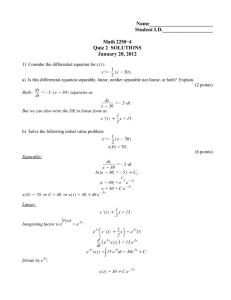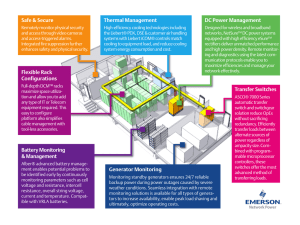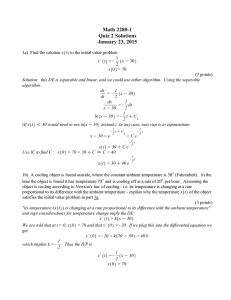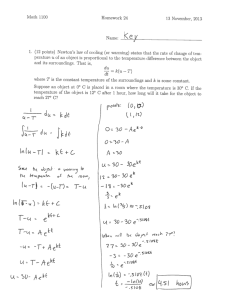Brian Fuchs Research Mentor: Dr. Adam Higgins
advertisement
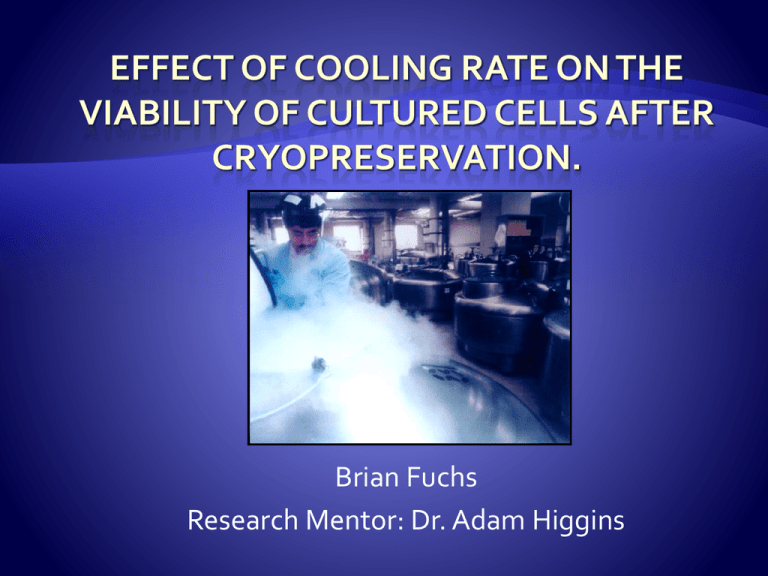
Brian Fuchs Research Mentor: Dr. Adam Higgins Long-term storage of living material at extremely low temperatures Cryopreservation is currently implemented in: Artificial insemination Storage of certain types of cells (e.g. blood cells) Future applications of cryopreservation are: Long term storage of tissues Long term storage of organs Use in cell-based biosensors 2 main types of cellular damage: 1. Intracellular ice formation (IIF) Damages membranes and cell structure 2. Cellular dehydration and solution effects 3rd type of damage is extracellular ice formation. Typically is significant only in tissue freezing Vitrification is the process of freezing a substance to a point where it becomes a glass like amorphous solid Prevents death due to IIF. 2 ways being investigated to prevent cell damage: 1. Addition of cryoprotection agents (CPA) 2. Adjustment of cooling rates CPA’s are chemicals that are permeable to cellular membrane Help to depress freezing point and prevent ice crystal formation Some examples are glycerol and DMSO. Goal: determine cooling rate for optimal cell viability. High cooling rate intracellular ice formation (IIF) Low cooling rate cellular dehydration and solution effects Solution Effects SURVIVAL COOLING RATE IIF The optimum cooling rate for maximal endothelial cell viability is about 5 ºC/min. Supercooling 0.7 30 0.6 10 ºC/min 0.5 20 ºC/min 10 ºC/min 25 0.4 40 ºC/min 0.3 80 ºC/min 0.2 130 ºC/min 0.1 Equilibrium 0 0 -20 -40 -60 Temperature (ºC) -80 Supercoling (ºC) Cell Water Volume (Vw/Vw0) Normalized Water Volume 20 20 ºC/min 15 40 ºC/min 10 80 ºC/min 5 130 ºC/min 0 0 -10 -20 Temperature (ºC) -30 -40 Culture cells on a slide Add CPA Run controlled rate freezing process Thaw cells Perform live-dead staining Temperature (ºC) 0 -20 -40 40 ºC/min -60 10 ºC/min 5 ºC/min -80 -100 -120 Time Live cells stained with calcein-AM Live cells stained with ethidium homodimer Dead cells stained with calcein-AM Dead cells stained with ethidium homodimer 1 Recovery of Adherent Endothelial Cells at Varying Cooling Rates 0.9 SURVIVAL 0.8 Recovery 0.7 0.6 0.5 0.4 0.3 Solution Effects COOLING RATE 0.2 0.1 0 Control 5 ºC/min 10 ºC/min Cooling Rate 40 ºC/min IIF There is a significant correlation between cooling rate and cell viability. Of the experiments performed, cooling rates of 5 ºC/min provided maximum cell recovery. More experiments are needed to determine if cell viability decreases at cooling rates lower than 5 ºC/min. CRF process is ready for use on cultured neurons. Dr. Adam Higgins Allyson Fry Nadeem Houran, Austin Rondema, Ingemar Hudspeth Dr. Kevin Ahern Howard Hughes Medical Institute

